


Corrugated shipping container, one type of cardboard box
|
|
| Type | Container |
|---|---|
| Inventor | Robert Gair |
| Inception | 1890 |
| Manufacturer | Various |
| Available | Globally |
Cardboard boxes are industrially prefabricated boxes, primarily used for packaging goods and materials. Specialists in industry seldom use the term cardboard because it does not denote a specific material.[1][2] The term cardboard may refer to a variety of heavy paper-like materials, including card stock, corrugated fiberboard,[3] and paperboard.[4] Cardboard boxes can be readily recycled.
Several types of containers are sometimes called cardboard boxes:
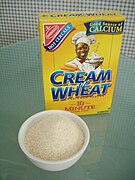

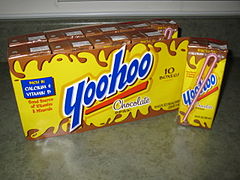


In business and industry, material producers, container manufacturers,[5] packaging engineers,[6] and standards organizations,[7] try to use more specific terminology. There is still not complete and uniform usage. Often the term "cardboard" is avoided because it does not define any particular material.
Broad divisions of paper-based packaging materials are:
There are also multiple names for containers:
The first commercial paperboard (not corrugated) box is sometimes credited to the firm M. Treverton & Son[9] in England in 1817.[10][11][12] Cardboard box packaging was made the same year in Germany.[13]
The Scottish-born Robert Gair invented the pre-cut cardboard or paperboard box in 1890 – flat pieces manufactured in bulk that folded into boxes. Gair's invention came about as a result of an accident: he was a Brooklyn printer and paper-bag maker during the 1870s, and one day, while he was printing an order of seed bags, a metal ruler normally used to crease bags shifted in position and cut them. Gair discovered that by cutting and creasing in one operation he could make prefabricated paperboard boxes. Applying this idea to corrugated boxboard was a straightforward development when the material became available around the turn of the twentieth century.[14]
Cardboard boxes were developed in France about 1840 for transporting the Bombyx mori moth and its eggs by silk manufacturers, and for more than a century the manufacture of cardboard boxes was a major industry in the Valréas area.[15][16]
The advent of lightweight flaked cereals increased the use of cardboard boxes. The first to use cardboard boxes as cereal cartons was the Kellogg Company.
Corrugated (also called pleated) paper was patented in England in 1856, and used as a liner for tall hats, but corrugated boxboard was not patented and used as a shipping material until 20 December 1871. The patent was issued to Albert Jones of New York City for single-sided (single-face) corrugated board.[17] Jones used the corrugated board for wrapping bottles and glass lantern chimneys. The first machine for producing large quantities of corrugated board was built in 1874 by G. Smyth, and in the same year Oliver Long improved upon Jones's design by inventing corrugated board with liner sheets on both sides.[18] This was corrugated cardboard as we know it today.
The first corrugated cardboard box manufactured in the US was in 1895.[19] By the early 1900s, wooden crates and boxes were being replaced by corrugated paper shipping cartons.
By 1908, the terms "corrugated paper-board" and "corrugated cardboard" were both in use in the paper trade.[20]
Cardboard and other paper-based materials (paperboard, corrugated fiberboard, etc.) can have a post-primary life as a cheap material for the construction of a range of projects, among them being science experiments, children's toys, costumes, or insulative lining. Some children enjoy playing inside boxes.
A common cliché is that, if presented with a large and expensive new toy, a child will quickly become bored with the toy and play with the box instead. Although this is usually said somewhat jokingly, children certainly enjoy playing with boxes, using their imagination to portray the box as an infinite variety of objects. One example of this in popular culture is from the comic strip Calvin and Hobbes, whose protagonist, Calvin, often imagined a cardboard box as a "transmogrifier", a "duplicator", or a time machine.
So prevalent is the cardboard box's reputation as a plaything that in 2005 a cardboard box was added to the National Toy Hall of Fame in the US,[21] one of very few non-brand-specific toys to be honoured with inclusion. As a result, a toy "house" (actually a log cabin) made from a large cardboard box was added to the Hall, housed at the Strong National Museum of Play in Rochester, New York.
The Metal Gear series of stealth video games has a running gag involving a cardboard box as an in-game item, which can be used by the player to try to sneak through places without getting caught by enemy sentries.
Living in a cardboard box is stereotypically associated with homelessness.[22] However, in 2005, Melbourne architect Peter Ryan designed a house composed largely of cardboard.[23] More common are small seatings or little tables made from corrugated cardboard. Merchandise displays made of cardboard are often found in self-service shops.
Mass and viscosity of the enclosed air help together with the limited stiffness of boxes to absorb the energy of oncoming objects. In 2012, British stuntman Gary Connery safely landed via wingsuit without deploying his parachute, landing on a 3.6-metre (12 ft) high crushable "runway" (landing zone) built with thousands of cardboard boxes.[24]
The first commercial cardboard box was produced in England in 1817, more than two hundred years after the Chinese invented cardboard.

Cardboard is a generic term for heavy paper-based products. The construction can range from a thick paper known as paperboard to corrugated fiberboard which is made of multiple plies of material. Natural cardboards can range from grey to light brown in color, depending on the specific product; dyes, pigments, printing, and coatings are available.
The term "cardboard" has general use in English and French,[1][2] but the term cardboard is deprecated in commerce and industry as not adequately defining a specific product.[3] Material producers, container manufacturers,[4] packaging engineers,[5] and standards organizations,[6] use more specific terminology.
In 2020, the United States hit a record high in its yearly use of one of the most ubiquitous manufactured materials on earth, cardboard. With around 80 percent of all the products sold in the United States being packaged in cardboard, over 120 billion pieces were used that year.[7] In the same year, over 13,000 separate pieces of consumer cardboard packaging were thrown away by American households, combined with all paper products, and this constitutes almost 42 percent of all solid waste generated by the United States annually. In an effort to reduce this environmental impact, many households have started repurposing cardboard boxes for eco-friendly purposes.
However, despite the sheer magnitude of paper waste, the vast majority of it is composed of one of the most successful and sustainable packaging materials of modern times - corrugated cardboard, known industrially as corrugated fiberboard.[8]
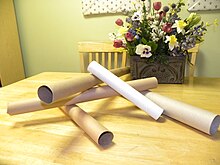
Various types of cards are available, which may be called "cardboard". Included are: thick paper (of various types) or pasteboard used for business cards, aperture cards, postcards, playing cards, catalog covers, binder's board for bookbinding, scrapbooking, and other uses which require higher durability than regular paper.

Paperboard is a paper-based material, usually more than about ten mils (0.010 inches (0.25 mm)) thick. It is often used for folding cartons, set-up boxes, carded packaging, etc. Configurations of paperboard include:
Currently, materials falling under these names may be made without using any actual paper.[9]

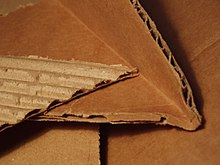
Corrugated fiberboard is a combination of paperboards, usually two flat liners and one inner fluted corrugated medium. It is often used for making corrugated boxes for shipping or storing products. This type of cardboard is also used by artists as original material for sculpting.[10]
Most types of cardboard are recyclable. Boards that are laminates, wax coated, or treated for wet-strength are often more difficult to recycle. Clean cardboard (i.e., cardboard that has not been subject to chemical coatings) "is usually worth recovering, although often the difference between the value it realizes and the cost of recovery is marginal".[11] Cardboard can be recycled for industrial or domestic use. For example, cardboard may be composted or shredded for animal bedding.[12]
The material had been first made in France, in 1751, by a pupil of Réaumur, and was used to reinforce playing cards.[citation needed] The term cardboard has been used since at least 1848, when Anne Brontë mentioned it in her novel The Tenant of Wildfell Hall.[13] The Kellogg brothers first used paperboard cartons to hold their flaked corn cereal, and later, when they began marketing it to the general public, a heat-sealed bag of wax paper was wrapped around the outside of the box and printed with their brand name. This development marked the origin of the cereal box, though in modern times the sealed bag is plastic and is kept inside the box. The Kieckhefer Container Company, run by John W. Kieckhefer, was another early American packaging industry pioneer. It excelled in the use of fiber shipping containers, particularly the paper milk carton.






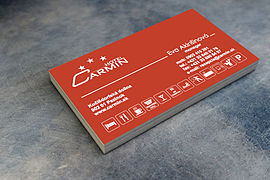

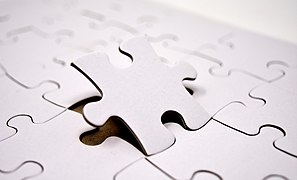
|
|
This article needs additional citations for verification. (November 2023)
|



A box (plural: boxes) is a container with rigid sides used for the storage or transportation of its contents. Most boxes have flat, parallel, rectangular sides (typically rectangular prisms). Boxes can be very small (like a matchbox) or very large (like a shipping box for furniture) and can be used for a variety of purposes, from functional to decorative.
Boxes may be made of a variety of materials, both durable (such as wood and metal) and non-durable (such as corrugated fiberboard and paperboard). Corrugated metal boxes are commonly used as shipping containers.
Boxes may be closed and shut with flaps, doors, or a separate lid. They can be secured shut with adhesives, tapes, string, or more decorative or elaborately functional mechanisms, such as catches, clasps or locks.
Several types of boxes are used in packaging and storage.
Depending on locale and usage, the terms carton and box are sometimes used interchangeably. The invention of large steel intermodal shipping containers has helped advance the globalization of commerce.[1][2]
Boxes for storing various items in can often be very decorative, as they are intended for permanent use and sometimes are put on display in certain locations.
The following are some types of storage boxes :
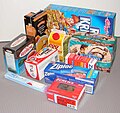










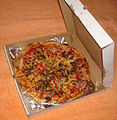



This was the first supplier I visited and interacted with after starting work in Australia. And it was a very good experience. Simon was very helpful towards a South African (;-)) and supplied the boxes I required, even though it was a very small order to begin with. A relationship was found and I will be using this company going forward, as well as recommending them to others.
After many years of excellent service we've stayed with Boxes For Business because they can always give us what we need in terms of box sizes and quality. Orders are processed easily and fast, and the prices are very reasonable compared to other companies. Give Simon a call and you will be very happy with the friendly vibe at Boxes For Business and the great customer service.
I have been doing business with Boxes For Business for over 10 years, their supply for second hand boxes (good quality) at the right price is great. Phone sales are very helpful and never a problem to find an alternative product if needed. Never a delay with deliveries as well. I can highly recommend Boxes for Business for all your second hand or new boxes.